Every Day is Like Christmas
An Interview with Art Krummel written by rewriting service providing https://writology.com/rewriting company.
|
Art Krummel has described his career as a newspaper illustrator and art director as being "like Christmas morning" every day. Having taken early retirement, he is now pursuing his lifelong dream of being an oil painter. One might reasonably conclude that Norman Rockwell has been a major inspiration; he's mentioned six times in the interview. — Editor |
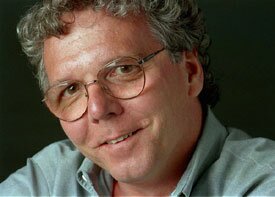 When did you start your art career?
When did you start your art career?
I knew I wanted to be an artist from the age of 11 or 12. I started with a book on how to draw squirrels, bears, and objects using simple shapes. I was hooked. I remember an early sketching trip when I was trying to draw a garbage can beside a garage. I couldn’t get the garage right and it frustrated me. I still have the sketch and now realize that I just didn’t know about perspective.
In high school I started visiting ad studios and was fascinated with the art of ad layout, lettering and line illustration. I also became an avid fan of Norman Rockwell’s work and decided I wanted to paint like him. I often went to a used book store that had old magazines in the basement. I would leaf through hundreds of old magazines looking for Rockwell illustrations. When I’d find one I’d buy the magazine for a nickel or dime.
Did you have a mentor?
One of the artists at an advertising art studio kind of took me under his wing and gave me brushes and white paint and paper and things. He gave me instruction on drawing an eye and eyeball. Jack was his name and he was so instrumental in my continued development as an artist. When I’d come into his area, he’d announce “here comes the aspiring artist or is it the perspiring artist” and then laugh heartily. He was my earliest mentor and I never forgot how he helped me. I have made it a point to mentor young artists in that same way. I think, as artists, we have an obligation to pass on our knowledge and fever to the next generation.
 Did you go to art school or are you self-taught?
Did you go to art school or are you self-taught?
Early on I was entirely self-taught. I took art in high school and became a bit of a known artist at my school. My art teacher was a wonderful lady but was mostly into things like masks and paper mache. I do remember an illustration assignment for the class where I painted a golfer hitting a golf ball directly at the viewer. I truly loved doing that piece (I wish I had it now) and from there I knew I wanted to be an illustrator.
After I graduated (and did the obligatory hitchhike around the country), I got a job at the local newspaper as a copy boy. With a full-time job, I immediately enrolled in some art classes in a nearby city. I hung around the art department at the newspaper and got to know the artists.
I had worked fervently toward becoming the next Norman Rockwell and had some samples of work I’d done in that style as well as some line drawings and lettering etc. that I showed to the artists as I did them. I also took an airbrush course at the art school, important because the artists did a lot of photo retouching. Later the airbrush became a favorite tool for rendering illustrations.
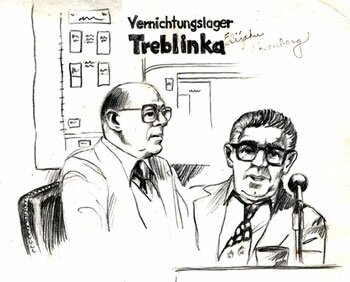 Suddenly, and sadly, one of the artists died and I was invited to join the department. What a thrill. I was a young raw kid artist with a mile of ambition and about an inch of ability. I was a lucky man to be hired. In those days they didn’t require a degree or a million applicants to choose from. They just said I was the one and that was it.
Suddenly, and sadly, one of the artists died and I was invited to join the department. What a thrill. I was a young raw kid artist with a mile of ambition and about an inch of ability. I was a lucky man to be hired. In those days they didn’t require a degree or a million applicants to choose from. They just said I was the one and that was it.
I soon enrolled in the art program at the University of Akron and eventually got a BS in graphic design. During that time I became senior illustrator and eventually the art director.
I spent 40 years at the newspaper. Every day of those years was like Christmas morning for me. I was making a living doing something I loved and each day presented a new challenge. I was allowed to do courtroom sketching in a number of trials including a mob murder (very nerve wracking) and a deportation trial of an accused ex-nazi concentration camp guard. I could barely concentrate during testimony from camp survivors. I would catch myself mesmerized by their testimony and not sketching. It was very moving.
 Often I would get to illustrate topics very dear to me. During the time I was an avid record collector of early R&B and R&R, there were numerous record collector shows and I got to do an illustration for a story about one. All of the records in the illustration are very authentic, extremely rare and accurately rendered. It was so much fun for me to do. I put a lot of detail in the drawing that never could be seen in the reproduction. Hey, I didn’t care. It was even more fun because I used a caricature of myself as the collector. What an enjoyable fantasy.
Often I would get to illustrate topics very dear to me. During the time I was an avid record collector of early R&B and R&R, there were numerous record collector shows and I got to do an illustration for a story about one. All of the records in the illustration are very authentic, extremely rare and accurately rendered. It was so much fun for me to do. I put a lot of detail in the drawing that never could be seen in the reproduction. Hey, I didn’t care. It was even more fun because I used a caricature of myself as the collector. What an enjoyable fantasy.
How has your work evolved?
Since I’m just transitioning from a career as an illustrator/graphic designer to a life as a painter, and my heroes are Norman Rockwell and Michelangelo, one would think that I’m a true blue realist. In my heart I would love to do abstract paintings. My mind contains wonderful abstract images but every time I try to move those images to canvas, I fail miserably. One day I will make that transition but, for the time being, I’m having too much fun just painting as a realist.
What do you think has been you biggest achievement so far during your art career?
While an artist and art director, I was involved in two Pulitzer prize winning projects for the newspaper. I was the chief designer and illustrator for one of the projects, “A Question of Color” which was a year-long look at race issues in our community. We published a 3-4 part series once a month. I did most of the computer graphics for the project and the keystone illustration that the project became recognized for. I am very proud of my of my work on that project.
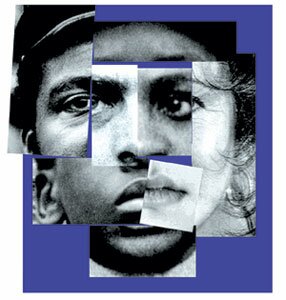 While I was enjoying a wonderful career employed as an artist, I was continually haunted with the thought that I should be painting and creating great masterpieces. When a person works 50 to 60 hours a week on the job, there is little incentive left for work at home.
While I was enjoying a wonderful career employed as an artist, I was continually haunted with the thought that I should be painting and creating great masterpieces. When a person works 50 to 60 hours a week on the job, there is little incentive left for work at home.
During some of those years, I took a week of vacation in the winter and spent the week at home living as an artist in a garret. I painted during day and night, even ignoring showering and shaving some days. I just painted and I loved just BEING an artist, living the life of a real artist.
That was life then. I’m embarking on a new career now. I loved that time, but that is behind me. I took an early retirement so today I can live the life I only dreamed about then. I am BEING an artist or more importantly a painter. I am obsessed with painting.
Have you any regrets in terms of taking your career?
As I said earlier, during my career as an illustrator, every day was like Christmas. No regrets unless you hate peace, joy, gifts and love. That would describe my life as an artist to date.
Where do you find inspiration?
I am a student of Renaissance painting and painters. One of my favorites is Michelangelo and I study his work avidly. His work is one of the reasons I have such an interest in the human form. A lesser known renaissance artist, Andrea DelSarto, is another artist I very much admire. He was a great teacher of well known artists including the mannerist Jacapo Pontormo. They are very much the inspiration for my figurative work, even though I spend a great deal of time on landscapes and other genre of art.
My first love is figurative work, but mostly I love to put paint on canvas. The simple act of making brush strokes on a stretched canvas (I stretch my own—I feel it is a part of the process of giving birth) and smelling the paint and watching the wonderful color interactions that can’t be imagined but only experienced. What a rush that is.
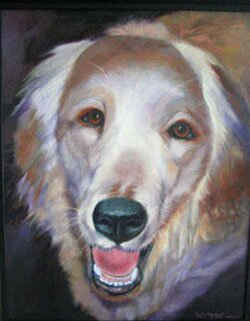 How do you come up with ideas for artwork?
How do you come up with ideas for artwork?
I paint anything. Still lifes, pet portraits, family heirlooms whatever moves me at a particular time. I have done a painting of my “grandpuppy” (daughter’s dog) and have in the works water lilies in my koi pond, the bridges over the Arno River in Florence and a pallete knife painting of an open air market in Munich (this one I’m doing with pallete scrapings when I finish a painting session). It is great fun to play with a pallete knife. It is something I’ve never tried and I am becoming increasingly intrigued with it.
In between landscapes and pets etc. I do figurative painting and drawing.
I don’t understand how anyone could be at a loss for ideas. Everything I look at looks like a painting to me. I am never at a loss for ideas.
Why do you find figures to be interesting subject matter?
There is probably nothing as beautiful as the graceful lines and shapes found in the human figure. It is the beauty of these forms and my feeling that rendering the human figure, not just accurately but with a fresh and exciting view, is the ultimate challenge for an artist. Anyone who can master drawing the human body well has achieved the highest pinnacle in art in my opinion.
There is a great deal of difference between a well-drawn and accurate figure and a piece that is fresh and moving and exciting. When the artist’s voice speaks through the work, it becomes more than good.
What constitutes a captivating pose?
The beauty and grace of the human form is emphasized with each twist and bend.
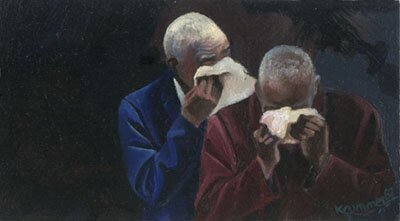 What do you think separates good art from great art?
What do you think separates good art from great art?
This a good question—or is it a great question? Everything is so subjective. There is one criteria that I believe makes a work of art grow beyond good. It is the ability of the piece to make the viewer stop, ponder, think about the message or emotion and walk away feeling somehow enlightened, entertained, or moved.
I once was viewing a show at the local art museum and most of the art (as usual) was interesting but I came upon a piece that consisted of small pieces of collected trash attached to the floor and wall. My initial reaction was just that: what a piece of trash. But I stopped and looked, I began to investigate the individual items, the Gem comb, the broken lunch box, the discarded butane lighter. I began to think about the people that once owned these items. It was amazing! I spent nearly an hour just looking. There was nothing esthetically pleasing about this work but, to me, it was great art. It did its job.
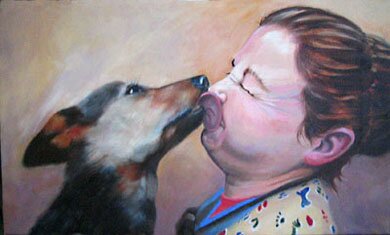 What do you think is the purpose of an artist?
What do you think is the purpose of an artist?
An artist’s job is to create work that pleases him/her. What that does for the world, hopefully, is that the artist’s approach is so fresh, so unique that it moves the viewer . Think Guernica, or Starry Starry Night, or Rockwell’s Four Freedoms. All very different styles of painting yet each image is burned into the viewer’s memory, the effect so profound.
What reaction from a viewer makes you happiest?
My happiest moments are when folks first see my new “baby” and they coo and cuddle. They visually want to hold it and love it. When I see those reactions, I am on a high that no drug in existence could duplicate. It is the simple confirmation that art is important and makes a difference in peoples’ lives.
What is your favorite media (oil, pastel, conté, etc)?
Oil by far.
You say that with such conviction. What makes oil paint so superior?
The painting medium, to me, is not simply a way to put color on a surface. Watercolor, pastel, acrylic—they're all fine for putting a color on a surface.
But oils involve all of your senses. There is a smooth, buttery texture that can be used like cake icing. Its body can contribute to defining a shape or add a dimensional quality. The ritual preparation for painting, squeezing color on the pallete, filling solvent and painting medium cups. The wonderful nutty sweet smell of fresh oil that fills the studio. The wonders of loading the brush with two separate colors and applying them letting the colors create the magic as they blend and swirl, standing apart at times, working together at others. All of this contributes to the oil painting activity. It embraces all of the senses. Even the clean up ritual, wiping the palette, washing the brushes. What peace that brings to me.
 By the end of a painting session I often feel exhausted and exhilarated because all of me has been involved. All of my senses engaged. When I visit the studio later in the night to study the work I did that day, the fresh oil smell of the room warms me, it brings a sense of joy.
By the end of a painting session I often feel exhausted and exhilarated because all of me has been involved. All of my senses engaged. When I visit the studio later in the night to study the work I did that day, the fresh oil smell of the room warms me, it brings a sense of joy.
There is nothing I know of that can duplicate the pleasure of painting in oil.
How long does it typically take you to complete a finished work?
It depends on the painting. A painting some of your readers may know “The Creation of Eve” took about a month working about 20 hours a week. I have a painting of bridges over the Arno River in Florence that I started nearly a year ago. I find the detail in the buildings very tedious so I tend to work on this painting in spurts. I finished a portrait of my daugher’s Golden Retriever in less than a week.
How do you know a piece is done?
When I reach a point where I don’t have anything else major to say and just start to “noodle” around. It’s “noodling” that has ruined many a painting.
What advice would you give to an aspiring artist?
If a person really is compelled to make art, to find time no matter the obstacle or use any material available whether it’s shoe polish (when you have no black ink) or food coloring (when you have no watercolors) applied to a cardboard gift box, then I say they must pursue their art to have a really fulfilled and happy life. It doesn’t have to be their livelihood (nice if it is) but it still must be a major part of that person’s life
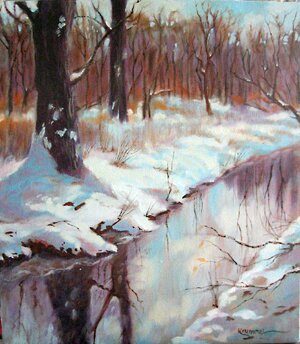 What are a few of your favorite art books?
What are a few of your favorite art books?
I have several books that I love. I refer to them constantly and reread areas when I need inspiration or instruction. Drawing Lessons from the Great Masters and Anatomy Lessons from the Great Masters as well as Master Class in Figure Drawing all written or co-written by Robert Beverly Hale. These are the three anchors of my library. In these books, the author speaks to me as one artist would speak to another. So many art books are written in a condescending way and few break any new ground. I have a new book called Oil Painting Secrets From a Master by Linda Cateura. The artist sharing his secrets is David A. Leffel. This again is presented as a book from one artist to another and is full of interesting factoids on a myriad of painting subjects. Interestingly all of these artists/authors are or were instructors at The Art Student’s League (where Norman Rockwell went to school by the way).
How can one acquire your work?
Currently, I am only showing locally and haven’t established a website yet. Having only resumed my painting career in the past year, my stable of paintings is yet to be fully rounded out. Eventually, I plan to establish a website and pursue gallery representation. First the paintings, the rest will come. Anyone interested in my work can contact me by e-mail at artkrummel![]() yahoo.com
yahoo.com
Do you accept commissions?
That will be my major focus this summer as I participate in the local art shows. I would welcome any commissions.
Thanks so much for allowing me to expound on creating art, a topic I love so dearly.
Thank you too. It's been a pleasure.
|
Facts at a Glance
|
|
|
Artist:
|
Art Krummel |
|
Location:
|
Ohio, USA |
|
Commissions Accepted?
|
Yes |
Artist-Perspectives.com Home Page
©2005Artist-Perspectives.com